FIFTH
GREBES NEST : APRIL - MAY 2008
New
nest after record Perth rainfall ...
20 May - saw a second adult in an adjoining stream
(but not together with the 'surviving' adult)
12 May - still only one adult - no trace of nest
6 May - DISASTER! - nest gone - one adult gone
1 May - one parent sitting while other grebe continues to add
material to the floating nest
24 Apr - both parents busy building new nest

FOURTH GREBES NEST
AND BABIES : OCTOBER - DECEMBER 2007
4
babies hatched in
this batch - one each day on 16, 17, 18 and 19 Nov 07
31 Dec - 4 young now adult
sized and mostly independent, only 1 parent grebe has remained,
although "pseudo duck" still spends a lot of time staying
safe near a Black Duck
and has adopted a mixed feeding style: part grebe diet and part duck
diet
22 Dec - 1 young grebe
(or "pseudo duck") regularly
hangs out close to a Black Duck
17,18 Dec - saw 1 adult go
ashore for a rest - leaving bossy baby
to feed itself!
14 Dec - bossy
baby with one parent, 2 babies with other parent, 1 baby feeding independently
12 Dec - nest completely gone
10 Dec - aggression has started again - biggest baby now biting others
5 Dec - parents still maintaining nest - used for roost every night
and also at times during day
4
Dec - all 4 babies going well, mainly around lake near a parent during
the day, both adults still taking turns feeding,
this batch of babies either very bright or well fed as diving from early
age - now doing quite long dives
(better food supply has resulted in all babies in this batch maintaining
a similar size)
21 Nov - mostly on or near nest but all 4 babies now also travelling
further away on parents backs
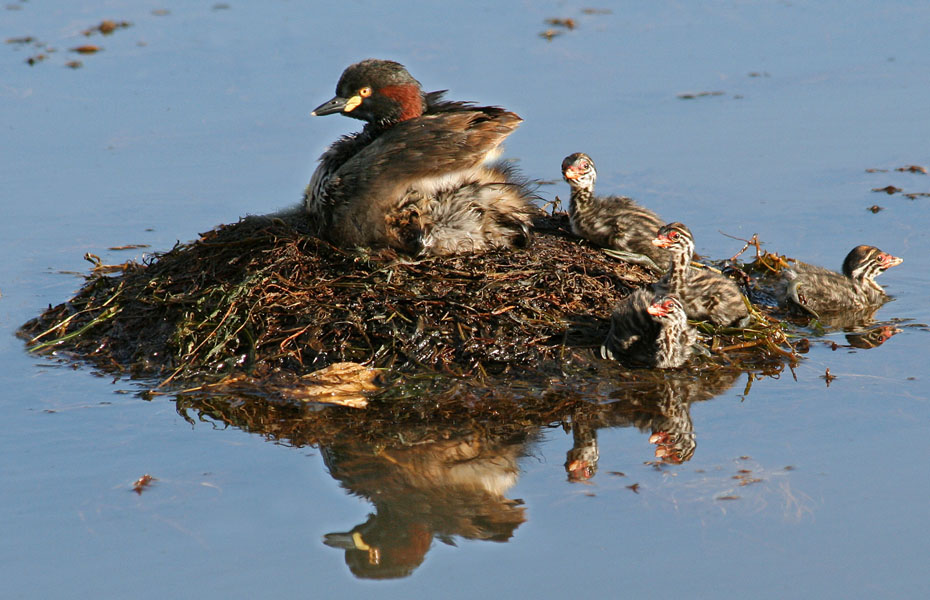

NEST AND BABIES : OCTOBER - DECEMBER 2007
3 babies hatched in this batch - late Nov 07 - overlook Moorish Cafe
18 Dec - babies 'overflowing' nest
10 December - 3 babies sticking heads over side of nest
4 December - small babies being fed in another tree within 10 metres of grebes nest
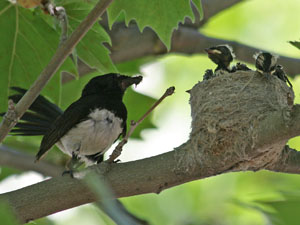
ready for food
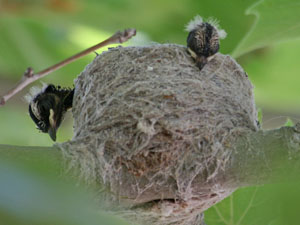
resting between feeds
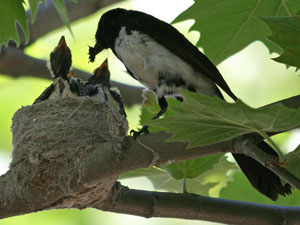
more food
NEST AND BABIES : SEPTEMBER - DECEMBER 2007
2 babies hatched in this batch - early Nov 07 - overlook grebes
18 Dec - babies out of nest
10 December - both babies almost ready to leave nest
4 December - 2 large babies still in nest
21 November - feeding babies
16 October - carrying feathers to tree within 10 metres of grebes nest
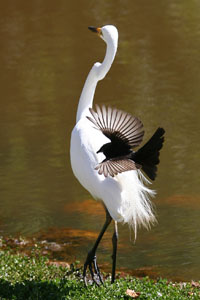
wagtail attacking egret
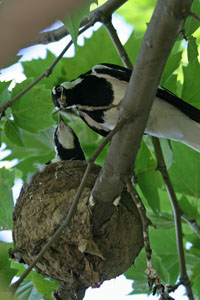
mudlark feeding baby
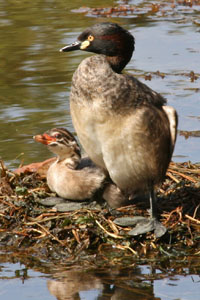
biting baby
SECOND COOTS NEST AND BABIES : NOVEMBER - DECEMBER 2007
5 babies hatched in this batch - one each day on 12, 13, 14, 15 and 16 Dec 07
31 Dec - only 2 adult Coots remain on the lake
22 Dec - all new babies have disappeared
18 Dec - tiny babies quite 'reckless', at times swim off well away from parents
17 Dec - babies leaving the nest for short periods
4 babies hatched in this batch - early Oct 07
17 December - both young adults healthy and independent on lake
21 November - 2 juveniles almost fully grown
25 October - second baby died, 2 surviving
16 October - one baby disappeared
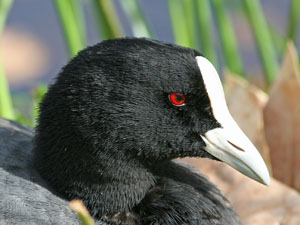
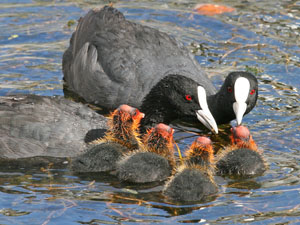
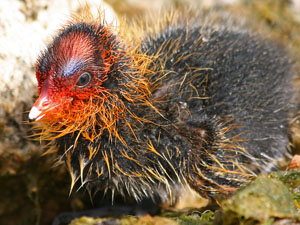
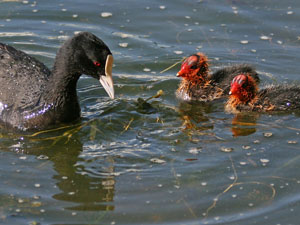
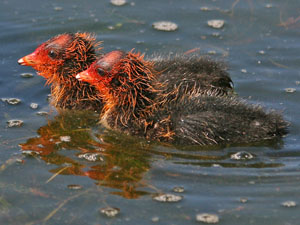
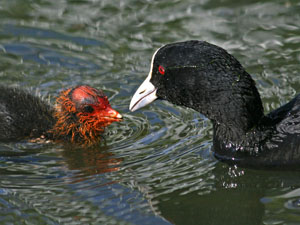

one of the young coots
The nest submerged after heavy rain flooded the lake
SECOND GREBES NEST AND BABIES : MARCH - APRIL 2007
4 babies hatched in this batch - one each day on 9, 10, 11 and 12 Mar 07
19 Apr - only 2 adults remaining on lake
17 Apr - baby almost adult size, although it stays near parent it no longer receives any food,
first heavy rainfall since summer ended has increased water levels
9 Apr - only one baby surviving - body of second baby floating in lake - starvation not predation!
(another lake near the Narrows Bridge also has only a single surviving baby)
6 Apr - still 2 babies alive, largest baby almost the same size as parents - it is a complete 'guts' - always cheep..cheep..cheep
and always chasing a parent for more food, the second baby is about half the size but forced to be more independent - only
fed by a parent about 50% of the day - finds quite a bit of food by itself and often stays alone around the lake,
water quality appears to be declining because of excess leaf litter and rubbish blown in by the wind
(but helped by the daily inflow of fresh water plus the aeration of the lake by 2 fountains)
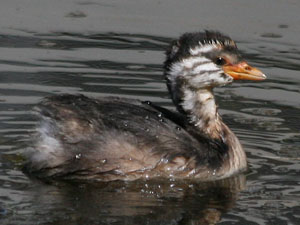
last surviving baby
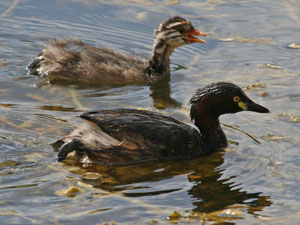
biggest baby after 4 weeks
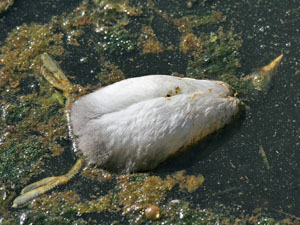
body of second baby
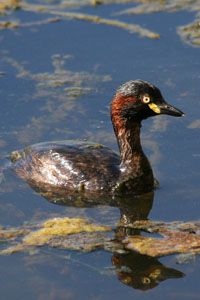
lake a bit slimy
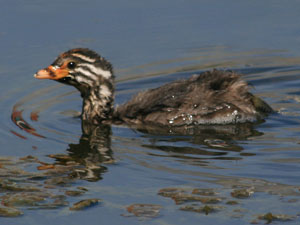
smaller more independent baby
(but not getting much food)

all in a line
over the last 2 months) but forced starvation by parents and biggest sibling!
26 Mar - I checked this evening and could only see 2 babies - at one stage only 1 baby was near a parent but the second
baby was hiding near the centre of the lake. At dusk the smaller baby was snuggling up on on the back of one parent while
the other parent was feeding the large baby. The nest has disappeared completely.
25 Mar - fourth baby was starved by parents and its bigger siblings - dead body on edge of lake
23 Mar -Survival of the fittest is cruel to watch - I took a photo of the big baby biting the smaller baby (see below) and
keeping it away from most of the food - even the parent was biting the smallest baby.

biggest baby grew to this size in 2 weeks
20 Mar - there has been plenty of life in the lake with both parents busy catching food and bringing it back to the babies
swimming near the nest or sitting on top of it - I have seen the parents catch dragonflies, shrimp like creatures and small fish.
With this batch of babies the parents built a well anchored nest which they are still maintaining - one parent stays on the
nest overnight with the babies, they are also using it as a resting place at various times during the day.
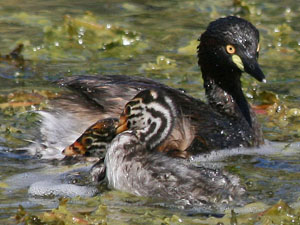
big baby biting

resting on nest
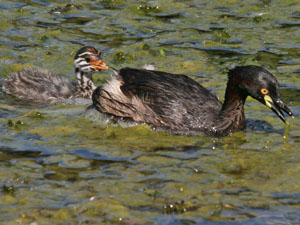
following parent
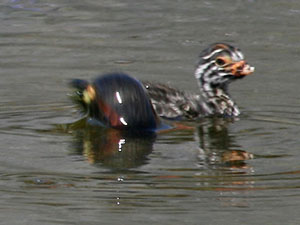
parent surfacing with food
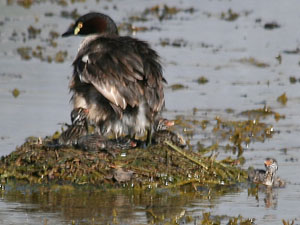
shaking the babies out ...
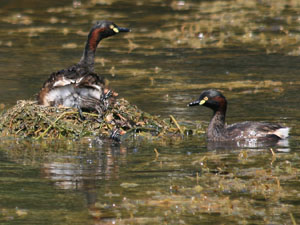
... before swapping roles

parent playing submarines to sneak up on food

parent with 4 babies about a week old
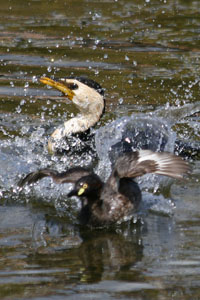
cormorant vs grebe

large dragonfly meal
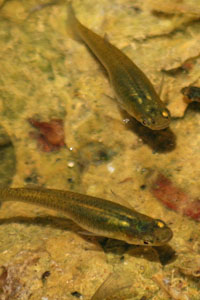
minnows in the lake
12 Mar 07: 4 babies have hatched so far.
11 Mar 07: Sighting of a new baby grebe by Alison.
8 Mar 07: Last 2 days were both over 42 degrees Celsius in the shade and bloody hot in the sun.
1 Mar 07: New nest is large, floating and well anchored, parent birds are taking turns incubating new eggs.
10 Feb 07: The parents have now started building a new nest in the centre of the lake.

Parents along side their floating nest - the incubating eggs have been covered over.
The birds decided to breed close to a major walkway near shops and apartments on a landscaped lake in East Perth.
The nest mostly stayed in the one place but some days moved more than 20 metres - probably due to the wind.
The Australasian Grebe's scientific name Tachybaptus novaehollandiae means 'fast sinking' and 'new holland'.
Grebes are aquatic birds with webbed toes that regularly dive under water to feed
but they can also submerge very slowly (a bit like a submarine).
Many local residents, workers and visitors have watched the grebes with interest since December 2006.
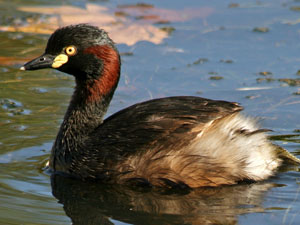
adult
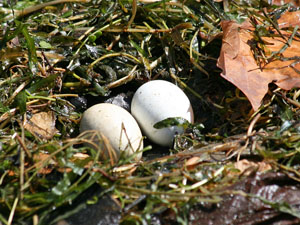
freshly laid eggs
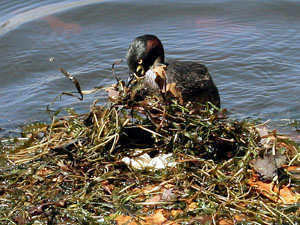
covering up the eggs
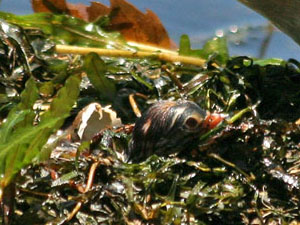
first baby to hatch
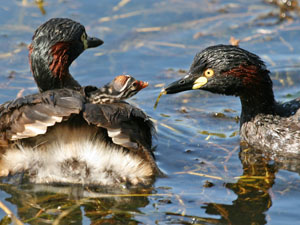
waiting to be fed while hitching a ride
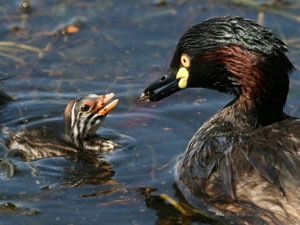
soon in the water feeding
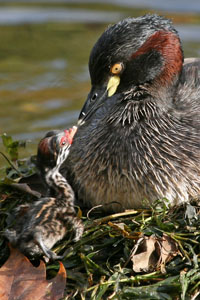
baby bonding with parent
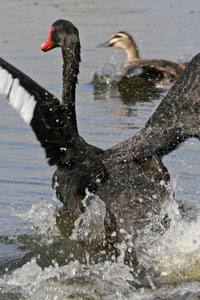
parent chasing away a swan
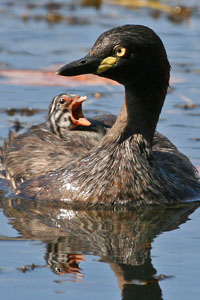
"I am hungry"
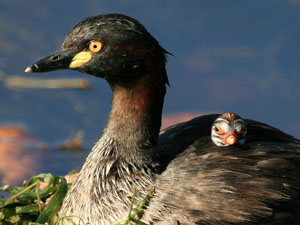
waiting for more eggs to hatch
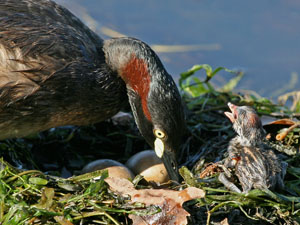
third baby to hatch was a bit weak
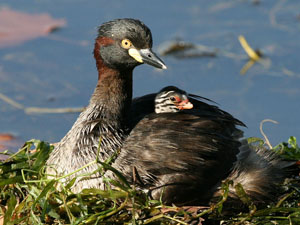
still waiting

Parent with the 3 babies that hatched - first on 31 Jan, second on 1 Feb and the third on 2 Feb 2007
(5 eggs were laid in total, nest and the last 2 eggs were abandoned after possible egg death in 40 degree Celsius heat wave)
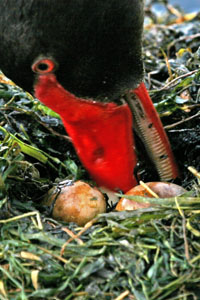
black swan feeding on the nest
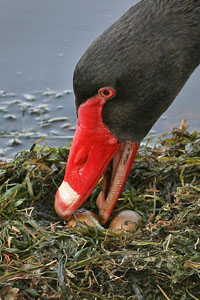
black swan picking up an egg
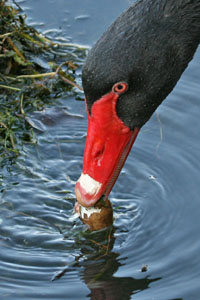
the baby inside appeared lifeless
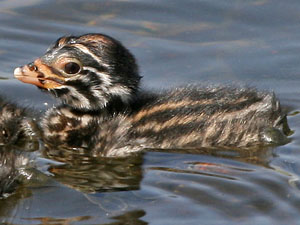
baby little grebe
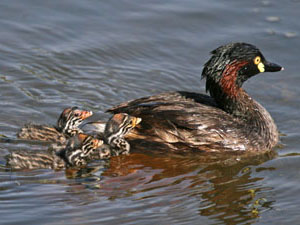
"follow me"
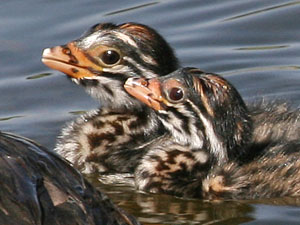
close up of 2 babies

parent feeding the 3 babies
Did abandoning the drifting nest make it too difficult to care for the babies?

Great Crested Grebe (Podiceps cristatus) on Lake Monger